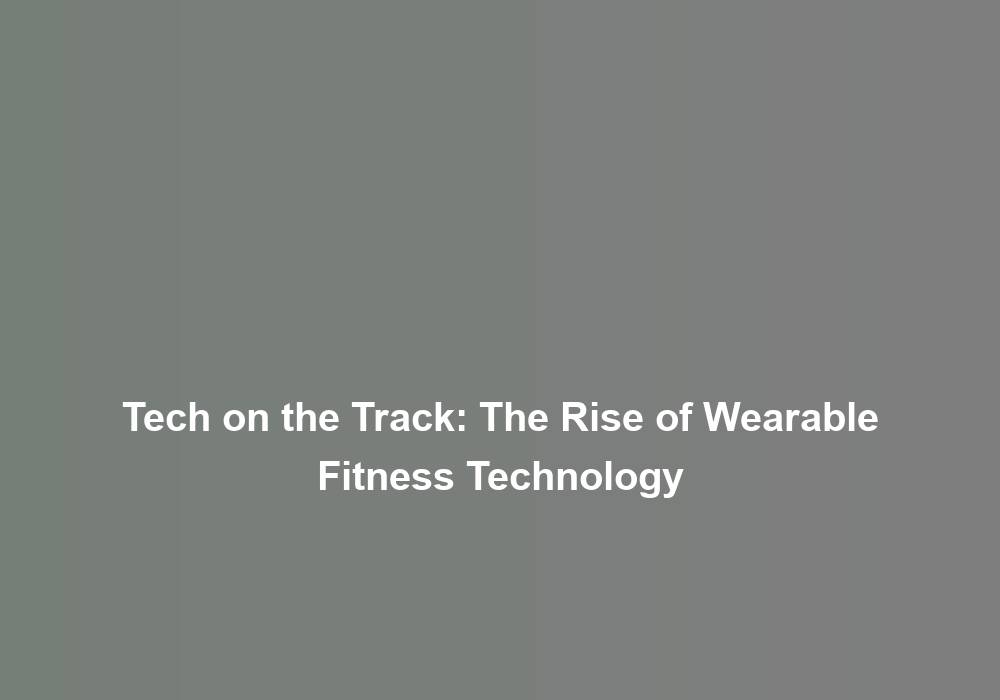Tech on the Track: The Rise of Wearable Fitness Technology
You lace up your running shoes, step onto the track, and feel the familiar rush of endorphins as you begin your workout. Just as you hit your stride, imagine if you could harness the power of real-time data to optimize your performance and track your progress. The evolution of wearable fitness technology has allowed athletes and fitness enthusiasts to do just that. From heart rate monitors to GPS tracking, these devices have revolutionized the way we approach exercise and training. But what exactly is driving this surge in wearable fitness tech, and how is it shaping the future of fitness?
Evolution of Wearable Fitness Devices
Over the past decade, wearable fitness devices have undergone a significant evolution, integrating advanced technology to track and enhance fitness activities. The evolution of wearable fitness devices has been driven by market trends that emphasize the fusion of fitness tracking with advanced technological capabilities. Initially, wearable fitness devices were limited to basic step counting and heart rate monitoring. However, the market demanded more comprehensive features, leading to the integration of GPS tracking, sleep monitoring, and workout intensity analysis. This evolution has transformed wearable fitness devices into sophisticated tools that provide users with in-depth insights into their physical activities.
As market trends continue to evolve, wearable fitness devices are now incorporating even more advanced features such as blood oxygen monitoring, stress tracking, and real-time workout feedback. These advancements are a response to the growing consumer desire for holistic health and wellness monitoring. Additionally, the evolution of wearable fitness devices has seen a shift towards seamless integration with smartphones and other smart devices, allowing users to conveniently access and analyze their fitness data.
Furthermore, the evolution of wearable fitness devices has also led to the emergence of specialized devices for specific activities such as running, swimming, and cycling. These activity-specific devices cater to the unique needs of fitness enthusiasts, providing tailored metrics and analysis for their chosen activities. As the market continues to evolve, we can expect wearable fitness devices to become even more sophisticated, seamlessly integrating into everyday life and offering a comprehensive approach to fitness tracking and enhancement.
Impact on Exercise and Performance
With wearable fitness technology, you can now track your workouts more accurately, gaining insights into your training and performance. These devices provide real-time data that enhances the accuracy of performance measurements, helping you optimize your exercise routines for better results. The impact of these advancements on exercise and performance is significant, empowering you to make informed decisions and achieve your fitness goals more effectively.
Improved Workout Tracking
Wearable fitness technology has revolutionized workout tracking, enhancing exercise routines and improving performance through precise data collection and analysis. HereG??s how it impacts your exercise and performance: 1. Real-time Feedback: Wearable devices provide immediate feedback on your workout intensity, form, and progress. 2. Personalized Training Plans: Utilize data to tailor workout plans that suit your fitness level and goals. 3. Competition Integration: Join fitness competitions and challenges to stay motivated and push yourself further. 4. Performance Analysis: Track your performance metrics over time to identify areas for improvement and celebrate achievements.
These advancements in workout tracking not only enhance your individual exercise experience but also foster a sense of belonging within the fitness community, driving you towards your goals with confidence and motivation.
Enhanced Training Insights
Enhanced Training Insights provide valuable data and analysis that optimize your exercise routines and elevate your overall performance. These insights offer personalized nutritional guidance, helping you understand the impact of different diets on your workouts. By tracking your food intake and correlating it with your exercise data, you gain a better understanding of how nutrition affects your performance. Additionally, recovery monitoring allows you to assess the effectiveness of your post-workout routines. With the help of wearable fitness technology, you can track your heart rate variability, sleep patterns, and muscle recovery, allowing you to make informed decisions about your training schedule and intensity. By leveraging these insights, you can fine-tune your workout strategies, minimize the risk of overtraining, and maximize the effectiveness of your exercise regimen.
Performance Measurement Accuracy
Measuring your performance accurately through wearable fitness technology directly impacts your exercise routines and overall athletic capabilities. The accuracy of performance measurement depends on several factors, including sensor technology and data validation. HereG??s what you need to consider:
- Sensor Technology: The quality and precision of the sensors in wearable fitness technology play a crucial role in accurately capturing your movements, heart rate, and other vital data during exercise.
- Data Validation: Reliable data validation processes ensure that the information collected by the wearable device is accurate and trustworthy, providing you with insights that you can confidently rely on.
- Calibration: Proper calibration of the wearable device is essential to ensure that the performance measurements align with your actual exertion levels and fitness progress.
- Impact on Training: Accurate performance measurement empowers you to make informed decisions about your training, leading to more effective workouts and enhanced athletic performance.
Advantages of Real-time Data Tracking
Real-time data tracking offers immediate insights into your fitness progress, allowing for timely adjustments and informed decision-making. This advantage is particularly beneficial for optimizing exercise efficiency. With real-time feedback on your performance, you can make instant adjustments to your workout intensity, duration, or technique, ensuring that you are making the most out of every session. By monitoring your heart rate, calories burned, and other relevant metrics in real-time, you can gauge the effectiveness of your workout and make adjustments as needed to maximize your results.
Additionally, real-time data tracking empowers you to make informed decisions about your fitness routine. Instant access to data regarding your performance and progress enables you to determine whether you are meeting your fitness goals and adjust your regimen accordingly. This level of insight allows for a more proactive and adaptive approach to your fitness journey, contributing to a greater sense of control and motivation.
Furthermore, real-time data tracking fosters a deeper understanding of your bodyG??s responses to different exercises and activities. By analyzing immediate feedback on factors such as heart rate variability and exertion levels, you can tailor your workouts to align with your bodyG??s specific needs and capabilities. This personalized approach can lead to more sustainable progress and reduced risk of injury, ultimately enhancing your overall fitness experience.
Personalized Health Insights and Analytics
With real-time data tracking providing immediate insights into your fitness progress, the next step is to leverage personalized health insights and analytics to optimize your exercise routine and overall well-being. By delving into personalized health insights and analytics, you can take your fitness journey to the next level. HereG??s what personalized health insights and analytics can do for you:
-
Customized Exercise Plans: Health monitoring and data visualization allow for the creation of personalized exercise plans tailored to your specific fitness goals and body metrics.
-
Performance Tracking: Gain a deeper understanding of your physical performance through detailed analytics, helping you identify areas for improvement and track your progress over time.
-
Health Risk Assessment: Utilize advanced analytics to assess potential health risks based on your fitness data, enabling you to take proactive measures to prevent future health issues.
-
Behavioral Insights: Receive personalized recommendations and insights based on your exercise habits and health data, empowering you to make informed decisions about your well-being.
Personalized health insights and analytics bring a new level of precision and customization to your fitness journey. By harnessing the power of data visualization and health monitoring, you can optimize your exercise routines, mitigate health risks, and make more informed decisions to support your overall well-being.
Integration Into Fitness Regimens
To fully maximize the benefits of wearable fitness technology, it is essential to seamlessly integrate it into your daily fitness regimens. One of the key advantages of wearable fitness technology is its ability to provide customized workouts tailored to your specific fitness goals and needs. By incorporating this technology into your routine, you can access personalized workout plans that adapt to your progress and preferences, ensuring that your fitness regimen remains dynamic and effective.
Moreover, wearable fitness technology serves as a constant source of fitness motivation. Through real-time data tracking and feedback, these devices offer immediate insights into your performance, keeping you motivated and accountable. Whether itG??s monitoring your heart rate, tracking your steps, or analyzing your sleep patterns, these devices provide tangible evidence of your efforts, driving you to push further and achieve your fitness goals.
Integrating wearable fitness technology into your fitness regimen also facilitates a more comprehensive approach to health and wellness. By utilizing the data and insights provided by these devices, you can make informed decisions about your workouts, nutrition, and overall lifestyle, leading to a more holistic and sustainable fitness journey.
Ultimately, the seamless integration of wearable fitness technology into your daily fitness regimen empowers you to take control of your health and fitness. With customized workouts, continuous motivation, and comprehensive insights, these devices become indispensable tools in your pursuit of a healthier and more active lifestyle.
Future Trends and Innovations
As wearable fitness technology continues to evolve, it is poised to usher in a new era of health and wellness advancements, shaping the future of fitness with cutting-edge innovations and trends.
-
Virtual Coaching and Interactive Experiences: The future of wearable fitness tech is moving towards personalized virtual coaching and interactive experiences. Imagine having a virtual trainer guiding you through workouts, providing real-time feedback, and creating immersive fitness experiences, all from the comfort of your own home.
-
Health Monitoring and Medical Integration: Wearable fitness technology is set to become even more integrated with healthcare, allowing for seamless health monitoring and medical integration. This means that your wearable device could not only track your fitness progress but also monitor vital health metrics and seamlessly integrate with healthcare providers to provide a more holistic approach to wellness.
-
Advanced Biometric Tracking: The future of wearables will include advanced biometric tracking, going beyond just heart rate and step count. These devices will be able to monitor a wide range of biometrics such as blood oxygen levels, hydration levels, and even stress indicators, providing a comprehensive view of your overall health.
-
AI and Machine Learning: The integration of artificial intelligence and machine learning into wearable fitness technology will revolutionize how data is analyzed and utilized. This will lead to more accurate insights, personalized recommendations, and adaptive training programs based on individual progress and goals.
These future trends and innovations are set to revolutionize the fitness industry, bringing about a new era of personalized, data-driven, and integrated approaches to health and wellness.
Conclusion
In conclusion, wearable fitness technology has revolutionized the way we track and optimize our exercise routines. From step counts to heart rate monitoring, these devices provide real-time data that can enhance performance and provide personalized health insights. With the integration of AI and advanced sensors, the future of wearable fitness tech looks promising. Stay tuned for the latest trends and innovations in this rapidly evolving field.







